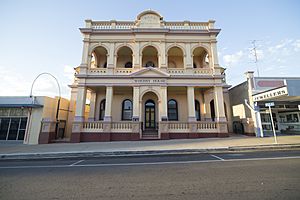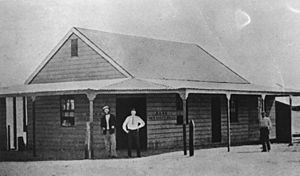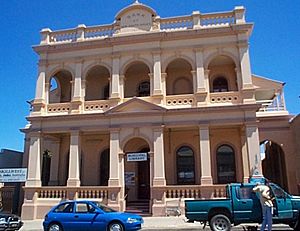Bank of New South Wales building, Charters Towers facts for kids
Quick facts for kids Bank of New South Wales, Charters Towers |
|
|---|---|

Bank of New South Wales (now Wherry House), 2015
|
|
| Location | 34–36 Gill Street, Charters Towers City, Charters Towers, Charters Towers Region, Queensland, Australia |
| Design period | 1870s–1890s (late 19th century) |
| Built | 1889 |
| Architect | Eyre & Munro |
| Architectural style(s) | Classicism |
| Official name: Bank of New South Wales (former) | |
| Type | state heritage |
| Designated | 9 November 2012 |
| Reference no. | 602804 |
| Significant components | banking chamber, strong room, banking chamber, residential accommodation – manager's house/quarters, bank |
| Builders | Kelleher |
| Lua error in Module:Location_map at line 420: attempt to index field 'wikibase' (a nil value). | |
The Bank of New South Wales building in Charters Towers is a very old and important place. It used to be a bank and is now known as Wherry House. Built in 1889, it was designed by architects Eyre & Munro and constructed by Kelleher. This building is listed on the Queensland Heritage Register because of its historical importance. It shows how much Charters Towers grew during the gold rush.
Contents
A Golden Beginning
Gold Discovery in Charters Towers
Gold was first found in Charters Towers in December 1871. An Aboriginal boy named Jupiter made the discovery. He was looking after horses for prospectors Hugh Mosman, George Clarke, and John Fraser. A storm scared the horses, and while getting them back, Jupiter found a rich vein of gold.
Mosman quickly registered the claim in January 1872. He named the area Charters Towers after the Gold Commissioner. Soon, many people rushed to the area looking for gold. By August 1872, about 3,000 people lived there.
Early Settlements and Banks
The first settlement was called Millchester. It was about 2 miles from where Charters Towers grew. Charters Towers quickly became the main town. It had stores, hotels, and a butcher shop.
Finding gold deep underground needed special machines. This meant people needed money to buy equipment and pay workers. New laws helped people combine their gold claims. This brought in more money and helped the town grow.
Banks were very important for the goldfields. They helped people manage their money and buy gold. The Australian Joint Stock Bank and the Bank of New South Wales opened offices in Charters Towers by July 1872. This was only six months after gold was first found!
The Bank of New South Wales Expands
The Bank of New South Wales was Australia's first bank, started in 1817. It grew quickly, opening branches in new gold rush towns. Bank staff were encouraged to be the first to set up gold-buying agencies. By 1861, the bank had 37 branches across Australia and New Zealand.
The bank expanded into North Queensland because of people like Robert Towns. Branches opened in places like Townsville (1866) and Ravenswood (1870). The Charters Towers branch opened in 1872.
At first, the main bank office was in Millchester. But Charters Towers grew much faster. In 1876, the Bank of New South Wales moved its main office to Charters Towers. Millchester then became a smaller agency. This move showed that Charters Towers was becoming the most important town.
A Grand New Building
Why a New Bank?
Charters Towers became very wealthy in the late 1800s. Gold from the area was even shown at an exhibition in London in 1886. This made English investors want to put money into the gold mines. Many local people also became rich.
This wealth led to more banks and financial businesses. By 1887, there were five banks on Gill Street. Banks wanted their buildings to look grand and strong. This showed how stable and successful the bank was. They hired famous architects to design these important buildings.
Designing the Bank
The Bank of New South Wales bought land on Gill Street in 1887. They wanted to build a large brick building. Architects Eyre and Munro were chosen for the design. They had offices in Townsville and Charters Towers.
William Henry Allan Munro managed the Charters Towers office. Walter Morris Eyre was the senior partner. They designed many important buildings in North Queensland. These included churches, other banks, and schools.
Building the Bank
Mr. Kelleher was the builder for the new bank. Eyre and Munro oversaw the construction. The bank opened on Monday, May 13, 1889. People said it was "handsome and very pleasing." They called it "an imposing structure, superior to anything north of Brisbane."
The new building cost a lot of money. It was designed to be both a bank and a home for the manager. This was common for banks in regional towns.
Inside the Bank
The ground floor had the main banking area. It was decorated with polished cedar wood. There was plenty of space for customers. The manager's office was on the left. Next to it was the accountant's office, which was raised so the accountant could see everything.
Behind the main counter was a strong room for keeping money safe. It was fireproof. There was also a lavatory and a stationery room. The manager's private dining room was also on the ground floor.
A staircase led to the upper floor, which was the manager's home. It had a beautiful drawing room and a large bedroom. There were three other bedrooms and a dressing room. A balcony ran around three sides of the upper floor. The servants' quarters, including a kitchen and wash-house, were on the ground floor at the back.
Charters Towers' Peak and Decline
Gold and Banking in the Late 1800s
Even though there was a small economic dip in 1888, Charters Towers quickly recovered. The discovery of the Brilliant Reef, which produced a lot of gold, helped. By the late 19th century, Charters Towers was one of the biggest gold-producing areas in Australia.
The "T" shaped intersection of Mosman and Gill Streets became the financial heart of the town. Many banks, the post office, and other businesses were located there. The Bank of New South Wales was seen as the first bank to build a truly grand building in the town.
In 1893, some banks faced a crisis. But the Bank of New South Wales in Charters Towers gained more business. Successful mining companies moved their accounts to it. Even after the crisis, eight banks still operated in Charters Towers.
By 1899, Charters Towers was Queensland's second most important city. It had over 26,000 people. Gold production was at its highest, bringing in huge amounts of money. Banks played a key role in handling all this wealth.
The Decline of Gold and Later Uses
After 1914, gold mining in Charters Towers slowed down a lot. By 1917, it had almost stopped. The town's population dropped from 25,000 in 1900 to just 13,000 after World War I. Many homes and businesses were moved to other towns.
However, banks like the Bank of New South Wales stayed to serve the local farming community. The Bank of New South Wales continued to use the building until 1970. It had some repairs and changes over the years.
World War II Role
During World War II, the Charters Towers Bank of New South Wales played an important role. When Japanese bombing threatened branches in New Guinea, their records, cash, and gold were moved to Charters Towers. It became a temporary "custodian branch" for the New Guinea operations.
New Life for the Building
In 1982, the Bank of New South Wales changed its name to Westpac. The old bank building in Gill Street then became the council library and a child care centre. Later, it housed offices for training programs and school support services.
The building has had different tenants since the library moved in 2003. In 2006, it was renamed Wherry House. This was to honour Paul Wherry, a former mayor, and his wife Molly. They had done a lot for the city.
What Does it Look Like?
The former Bank of New South Wales is a large and important building in Charters Towers. It stands out among other buildings from the late 1800s. It faces north on Gill Street, close to Mosman Street. It looks similar in size and style to other old banks and important buildings nearby, like the Post Office.
The building is made of brick with a smooth, painted surface. It has a large roof covered with metal sheets. The front of the building on Gill Street has a fancy, two-story arched design. On the sides, there are timber verandahs (porches) on the first floor. These also create covered walkways on the ground level.
The building has three main parts:
- The old bank on the ground floor, entered from Gill Street.
- The former manager's home on the first floor, accessed from the side.
- A separate service building at the back, accessed from Powell Lane.
The building still looks much like it did when it was new. It shows high-quality work and details. The main rooms inside are large and decorative. They have high ceilings, beautiful cedar wood, and fancy plaster decorations. The strong room, where money was kept, has thick brick walls and a curved ceiling.
The original layout is still clear. When you enter, you come into the large banking area. The manager's office and accountant's space are on the left. The strong room and other small rooms are at the back. A separate staircase leads to the manager's apartment upstairs. This apartment has large main rooms at the front and smaller bedrooms at the back. Many rooms have French doors opening onto the verandahs.
At the very back, there's a smaller building. It used to have a servant's bedroom and a kitchen. It also has verandahs on its sides.
Why is it Important?
The former Bank of New South Wales building was added to the Queensland Heritage Register in 2012. This means it's a very important historical site.
A Piece of Queensland's History
This building helps us understand the history of gold mining in Queensland. Gold mining was a huge part of Queensland's wealth. Built in 1889, the bank shows how important financial services were for the deep gold mining industry in Charters Towers. By the 1890s, Charters Towers was the biggest gold producer in Queensland.
The building also shows how the Bank of New South Wales grew. It was the first bank in Australia and Queensland. It expanded quickly with the growth of farming and mining from the 1860s. It was one of the first banks to open in Charters Towers in 1872.
This 1889 building was the first large, two-story brick bank in Charters Towers. It served as both a bank and the manager's home for over 80 years. It shows how banks wanted their buildings to look grand and strong. This helped show the bank's wealth and success in the town's business centre.
A Great Example of Bank Design
Designed by famous North Queensland architects Eyre and Munro, this bank building is a great example of their work. It is still very much like it was when built. It shows what a large, regional bank from the 1800s looked like.
Its two-story brick design and fancy classical style make it stand out. The large banking area, strong room, offices, and private manager's home are all key features. The building's original layout helps us understand how each room was used.
Beautiful and Expressive
The bank building is important because of its beauty. Its grand, arched front shows the financial stability and strength that banks wanted to convey back then. It looks great on the street and is one of many large brick bank buildings in Charters Towers. The town itself is an important example of a gold rush town from the 1800s.
The building also has many high-quality decorations and wooden details inside. These show the different importance of the rooms and the style of the 1800s.



